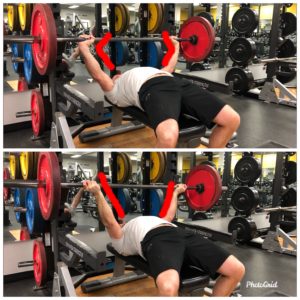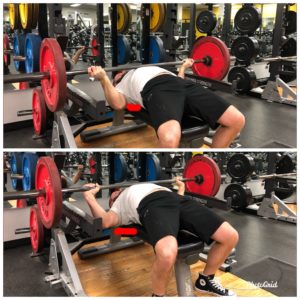The bench press is arguably the best measure of upper body strength and probably the most popular exercise in any gym. However, it is also the cause of shoulder injuries and pain for many.
From my experience, this is due to many people butchering the bench press, like the Gym Bros that load two plates on the bar without even a warm up. They then lower the bar less than half way down just to have their spotter upright row the bar back up for them… But that’s a topic for another post.
The problem I’ve noticed is more so with the wide grip bench than the narrow. Benching with a wide grip shortens the range of motion and allows for more weight to be lifted, but it also makes it hard to keep the elbows tucked in properly which can make your shoulders unstable. I unfortunately learned this the hard way.
With my short T-rex arms and a wide grip, I hit some respectable numbers in the bench press. After over a decade of heavy wide grip benching, my shoulders were fucked and my numbers plummeted. Eventually I got to the point where I was lucky if I could bench a plate without pain in my rotator cuffs and neck. I had pinching in my shoulders and neck even when lifting my arms above my head.
Enter the reverse grip bench press. It is one of the rarest exercises performed in any gym, in fact most people don’t even know it exists.
Holding the bar backwards allows the elbows to remain tucked in properly even with a wide grip, keeping your shoulders in a safe and stable position. This position keeps your wrists and forearms in a straighter line, alleviating any pain in your wrists. It targets the upper pecs better than incline benching and forces the triceps to engage more.
If you have short arms like I do, you might find it hard on the wrists to take a wide grip benching the conventional way, for those of you with long arms it becomes less of an issue.
For example, notice the difference in wrist angle between the reverse grip bench press and the standard bench press.
In this photo, you can see the difference in how with the reverse grip bench press, I’m able to tuck my elbows in a considerable amount.
Performing the reverse grip bench press:
The set up:
- Lie on the bench
- grab the bar tightly with a moderate to wide grip
- make sure the bar is sitting in the middle of your palms not too close to your thumbs.
- (You do not want the bar to sit on your thumbs otherwise the bar will want to roll out of your hands, this was the hardest part of the RGB for me)
- plant your feet firmly on the floor
- squeeze your shoulder blades together and your chest should naturally come upwards
- tighten your abs and use your legs to drive your upper back and traps into the bench.
- Do not lift your butt off the bench, you should be driving your body back onto your traps, not up off the bench.
- Ensure that your entire body is tight
- you need to create a solid platform before you even unrack the bar
Lowering the bar (the eccentric phase):
- unrack the bar
- fill your abdomen full of air and hold it till the lift is complete
- lower the bar to your chest, keeping your shoulder blades tight.
- The bar should touch your chest and even sink into it a little.
- pause for a split second
The lift (concentric phase):
- push the bar up off of your chest
- keep your shoulder blades tight.
- The harder you push the bar, the harder you should squeeze them together!
- when you get to the top, finish by locking out your triceps
- rack the bar
This reverse grip bench press took me months to learn. It felt awkward as fuck and felt like I was doing it wrong at first. Finding a grip width and hand placement that worked for me was very time-consuming. But I eventually found my groove.
All of a sudden, I was able to consistently add on weight week to week and my shoulders felt great. Since switching to a reverse grip, I’ve been able to bench double my bodyweight raw. And without pain.
Pros of the reverse grip bench press:
- engages triceps more than traditional benching*
- targets the upper pecs more than incline benching*
- keeps your shoulders in a stable position
- allows you to take a wide grip and keep your wrists straight
- allows you to take a wide grip and keep your elbows tucked in
- allows you to achieve the same benefits as the conventional bench without the risks of shoulder instability and impingement
Safety tips and precautions when performing the reverse grip bench press:
- grip the bar tight to keep it from rolling off of your hand
- use lots of chalk to keep a tight grip
- make sure the bar is sitting securely on your palms and not all the weight is on your thumbs
- if possible, get a lift off the rack from a spotter
- proper set up is more important than ever with the RGB.
- Setting up with a good arch and driving with the legs to dig your traps and upper back into the bench is not only the proper way to lift maximum weight but will also make unracking the bar easier.
- the bar path will be a little different than regular benching so make sure you practice staying in your groove before increasing weight.
Give the reverse grip bench press a try and don’t be too quick to give up on it! Give yourself time to learn the lift and your shoulders will thank you!
Lockout powerlifting sample bench workout (2 bench days a week):
1St bench day:
-reverse grip bench press: 3-4 sets of 3-4 reps in the 85-90% 1RM
-Incl. bench: 4 sets of 10
-DB rows superset face pulls: 5 x 10
2nd bench day:
-narrow reverse grip bench press: 3-4 sets of 3-4 reps at 85-90%
-DB overhead press: 4 sets of 10
-pullups superset face pulls 5x10
*Ref: https://www.muscleandfitness.com/flexonline/training/incline-vs-reverse-grip-bench-press


